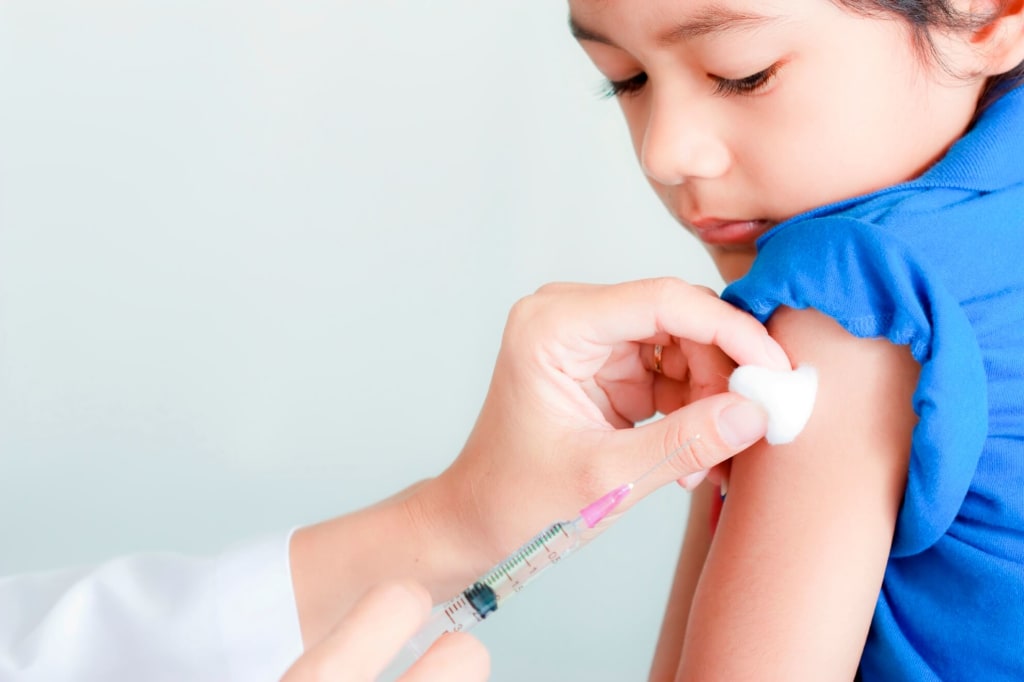Vaccinating Children
Keeping Our Community Safe

Many lives are taken by diseases that could have been prevented if only they’d had the vaccination. Vaccinating children is important, because it keeps our society clear of diseases that were considered “extinct” before. Vaccines are the beginning step towards worldwide eradication for any disease.
The ultimate outcome of worldwide immunization is worldwide eradication and vaccines are the beginning steps towards this. To this day the only disease to be eliminated completely worldwide is smallpox. Polio is close behind, because it has been extinct in the Americas in 1994. Measles is currently the next disease on the list to be eradicated. Vaccines that have eliminated some diseases in the United States completely include diphtheria, smallpox, and polio. Rubella and measles follow closely with 99.9 percent eradication in the US.
One way to achieve world eradication is to simply vaccinate. Not only do vaccines protect individuals against viruses and diseases, but communities as well. “Vaccines are vital to the public health goal of preventing diseases.” The more people that are vaccinated in a community, the less likely an outbreak is to occur. For example, in 1989 vaccine rates dropped in the US and the amount of measles cases “skyrocketed.” There were over 55,000 cases and 136 deaths related back to the measles strain. Herd immunity is a big factor in preventing illness in large communities. This is when the higher portion of the community is vaccinated versus the portion that isn’t. This explains that vaccinations not only protect the host, but also individuals around them. There are 10,000 to 50,000 cases of whooping cough each year in the United States. Most of the babies that get pertussis, or whooping cough, are too young to receive the vaccine; therefore, they need to be protected by the people around them being vaccinated.
Whooping cough is a deadly respiratory disease caused by pertussis bacteria. The best way to prevent this strain is by getting the diphtheria tetanus pertussis shot. Common symptoms include runny/stuffed up nose, mild cough, and apnea in babies. There are more serious symptoms such as the coughing fits that can start one to two weeks after exposure to the bacteria. Many babies cough very hard over and over, and gasp for air after their coughing fits. They can have difficulty with breathing, and can turn blue during their fits because of the lack of oxygen to their body. Some can experience vomiting with their coughing fits. These fits can last up to 10 weeks and can sometimes reoccur. Whooping cough is most dangerous for babies. Most of them end up needing hospitalization because some acquire pneumonia, have seizures and suffer lifelong brain damage.
In the 1950s whooping cough rates were higher at over 100,000 cases, leading to death in one in every 1000 children. That’s 100 unnecessary deaths that could’ve been prevented with the help of the vaccine. By 1974, as immunization rates got higher, the rates of whooping cough got lower. There were less than 10,000 cases reported. Shortly after, a study was published stating that the pertussis vaccine caused neurological problems. This lead to vaccination rates lowering again. After this study was published, there were two future outbreaks between 1977 and 1982 causing 50 unnecessary deaths. Once this study was disproved, vaccine rates rose once again.
Many believe vaccines are unsafe, even though these vaccines undergo a long process of tests and monitoring before they are given licensure and put on the market. “Vaccines are prescription-only medicines.” This means that the government regulates it. The first step of testing that a vaccine undergoes is being tested on a small group of healthy individuals to see if the vaccine really works. The goal of the second step of testing is to get the vaccine to become safe for the host. This means they’re checking to make sure antibody production is sufficient enough. Finally, in step three of testing, the short-term and long-term effects of the vaccine are watched closely.
A vaccination continues to be watched closely before it is given its final licensure. For example, in September, 1992 the MMR (Measles, Mumps, and Rubella) vaccine contained the strain of Urabe Mumps. Thorough surveillance revealed that it was causing meningo-encephalitis, therefore it was taken off the market. The Federal Drug Administration (FDA) regularly inspects facilities that manufacture the vaccine. This ensures the quality of the vaccine and its safety. The Advisory Council of Immunization Practices (ACIP) plays a key role in monitoring vaccines safeness and quality. They use data collected to discover the use for vaccines before distribution. They consider age as a main factor when looking into a vaccine. They determine how safe and how well the vaccine works based on the age of the host. The association also determines the severity of the disease that the vaccine is preventing. Based off of that data they estimate how many children could contract the disease if not vaccinated.
Taking it one step further, these recommendations don’t become finalized “until the CDC Director” has reviewed them. Once the director approves the recommendations they then become a “part of the US childhood immunization schedule.” As the vaccine is administered to the public, the FDA and CDC continue to monitor it closely. The main purpose of this is to search for any major adverse side effects that go along with the vaccine. The Clinical Immunization Safety Assessment Project (CISA) look into questions brought forth by “vaccine safety experts” regarding their patients and vaccine safety. Vaccines can later change if new discoveries are made. There are many other systems and organizations set up to monitor vaccines. The Vaccine Adverse Events Reporting System helps patients report any side effects they’re experiencing related to vaccines. The Vaccine Safety Datalink studies these self-reported side effects to see if they’re really directly related to the vaccine.
“United States currently has the safest vaccine supply in its history.” Vaccines provide immunity to diseases. There are antigens in vaccines, that are small amounts of weakened viruses that help the immune system fight back. Adjuvants are also present in some vaccines, which can “kickstart” the immune system to react along with the vaccination. Preservatives and stabilizers continue to keep the vaccine safe. Preservatives create a barrier for the vaccine against outside germs and bacteria whereas stabilizers maintain the vaccine while it is being stored.
Some commonly asked questions regarding vaccines include “can vaccines with thimerosal cause mercury poisoning?” The answer is “no” because methylmercury causes mercury poisoning, not thimerosal that is used in some vaccinations. Some are curious if people who are allergic to eggs can still be vaccinated; yes, they can. Even though eggs can be used in vaccines as cell cultures for growth, people who are allergic to eggs can still receive any recommended flu vaccination. There’s no longer a need to be monitored after receiving the vaccination. It is also questioned whether some of the chemical ingredients found in vaccinations are harmful. Formaldehyde and aluminum can be found in some vaccines, but they’re found in such small amounts that they aren’t considered harmful.
Misconceptions regarding vaccines still exist today leading to the lower rates of immunization. One major misconception is that “vaccines can overwhelm the immune system of a child.” As soon as an infant is exposed to the world they’re exposed to all kinds of new bacteria and pathogens. Children are exposed to more antigens daily than in any vaccine, therefore their immune systems couldn’t become overwhelmed. Another misconception is that since a disease is supposedly eliminated, vaccinations can stop. This is not the case. Just because a disease is considered to be eliminated, it doesn’t mean immunizations should stop. Any drop in immunization rates can spike an increase in disease rates. In the 1980s, there was a decline in immunization rates leading to an epidemic in the Soviet Union. This caused over 4,000 deaths due to diphtheria. In 1979, Japan declared the country free of pertussis and people stopped getting vaccinated. This lead to an outbreak of over 13,000 cases, causing 41 deaths. Similar to other countries, the US’s vaccine rates began to drop between 1989 to 1991, leading to 55,000 cases of preschoolers with measles.
Many cultures and religions still do not believe in vaccination, which can be the “loophole” to worldwide eradication. Thousands of lives have been taken by diseases that could’ve been preventable by vaccinations. Even though vaccines may cause slight discomfort, the advantages outweigh the minor discomfort. Without vaccines our world would be more life-threatening than it already is, but the key to worldwide eradication is having everyone vaccinate.
About the Creator
Madison Rheam
HACC graduate with Associates Degree in Social Sciences, LGBTQ+, raging liberal, feminist.






Comments
There are no comments for this story
Be the first to respond and start the conversation.